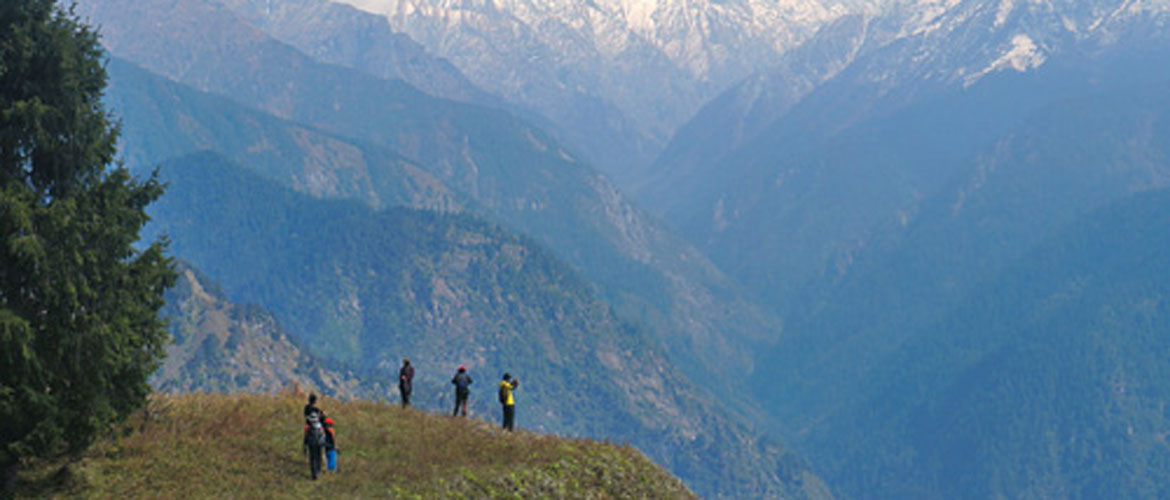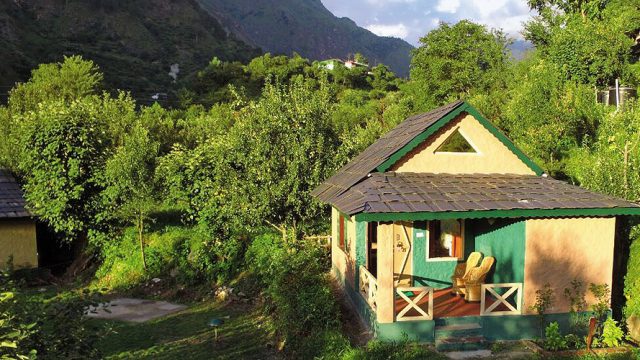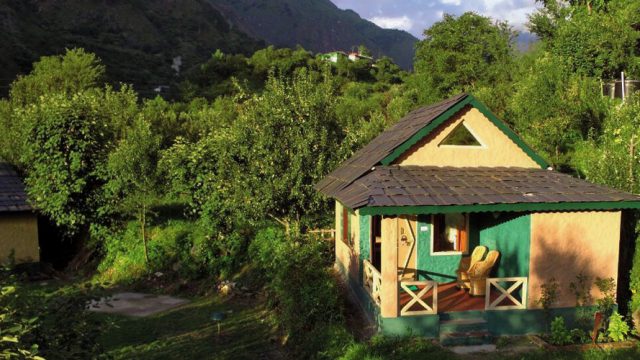The Great Himalayan National Park (GHNP) was notified in 1984 after a Himachal Wildlife Project
The procedure for the resettlement of villages that existed within the boundaries of the proposed park started in 1988, but the final notification of the park happened only in 1999.

The process of the creation of the park has, however, not been without problems. The notification of the park resulted in villagers being banned from collecting morel mushrooms and medicinal plants, and from grazing their sheep within park boundaries, all of which were important sources of income for them. Naturally, this created a lot of resentment amongst them. The villagers claimed that their absence from the forests had given poachers a free run of the park.
ORIENTATION
The Great Himalayan National Park (754sq km) consists of the watersheds of the Jiwa, Sainj and the Tirthan rivers and the river tributaries of the Beas. It is naturally protected on its eastern boundary by the Great Himalayan Range, and on the southern and northern boundaries by areas under permanent snow or by impassable ridges. The boundaries of the park are contiguous with the Pin Valley National Park in the Trans-Himalaya, the Rupi-Bhaba Sanctuary in the Sutlej watershed, and the Kanawar Sanctuary.
The park has four main entry points: Gushaini (about 34km from Aut) is the roadhead for trekking in the Tirthan valley, Neuli (40km from Aut) is where trekking trails in the Sainj valley start; while Siund village (30km from Aut) is the starting point for treks in the Jiwanal valley, and Barshaini (on the north-eastern fringe of the park) is the starting point for treks up to Mantalai and the Pin-Parvati Pass.
Tip The Sai Ropa ACF Office, about 5km before Gushaini, issues entry permits for the park. Trekking within this national park can be quite taxing. It is, therefore, essential to be in good shape. You will also need to carry basic trekking equipment such as tents, sleeping bags, a stove and utensils with you.
Biodiversity Tourism and Community Advancement, GHNP, Sai Ropa (Contact Gopal Krishna, Cell: 09418282148; W bcta.org.in), a local NGO, can arrange tour guides and equipment. This NGO is associated with the park. Sunshine Himalayan Adventures (Cell: 0941 8102083) also organises treks in the park. Packages include all meals and equipment. Guides It is essential to take a guide and porters with you when you are trekking in this national park. Contact the Director or Chief Conservator’s office in Shamsi (Tel: 01902-265320, Cell: 09418488222; W greathimalayannationalpark.org; Timings: 10.00am–5.30pm) for guides, trekking information and accommodation requirements.
FAST FACTS
When to go The park is open throughout the year, however, April–May is the best time to visit. By this time, the snow melts and the ground is clear of the grass, which makes climbing difficult. The monsoon rain and the winter snow make trekking fairly difficult. However, it is only in winters that animals such as the snow leopard and tahr descend from higher altitudes
Permits Available from the Tirthan Wildlife ACF Office at Sai Ropa (Tel: 01902-265320), and from the Jiwa Nal Wildlife Range Office at Larji. Permit fee: Indians ₹100 per day; Foreigners ₹400 a day for the first 5 days
Wildlife/ Forest Dept office
Director, GHNP, Shamshi
Kullu-175126
Tel: 01902-265320
STD code 01902
For GHNP area, Ved Ram (Cell: 09418844128) and Lal Singh (Cell: 08988410639) are trekking guides, or call Raju’s Guest House in Gushaini. Friends of GHNP rents out tents, sleeping bags, comfortable mats and utensils.
Main park trails can get impacted by landslides and floods. Staff of the Biodiversity and Community Tourism Advancement, should be contacted for trail status when planning a trek here.
Entry fee Indians ₹100; Foreigners ₹400 Timings Sunrise–sunset
Things to See & Do
The Great Himalayan National Park has vast tracts of virgin and unexplored forests. The only way to move through the park is by trekking (which can be difficult) and using the forest department’s huts for night halts.

Sainj Valley Trek (66km): Neuli (1,500m) – Shakti (2,100m) – Lower Meadow Bridge in the Homkhani Forest (2,800m) – Shakti – Neuli: This relatively easier trek takes you through dense forests in the Sainj Valley. You can also move further up to the high-altitude meadow of Dhel (3,737m), which is more difficult.
The Sainj-Tirthan Valley Trek, which I undertook is the best for spotting wildlife. It takes you through the valleys of the Tirthan and the Sainj rivers, via a range of forests – from dense oak and chestnut forests to high-altitude birch and rhododendron forest.
The stretch from Gushaini to Shilt is excellent for birdwatching. Shilt onwards, you enter bear territory – they’re extremely elusive so you will probably only see pugmarks, but you are quite likely to see ghoral, and possibly tahr. You will also probably see monal, koklass and, if you’re up early enough, you might just see the tragopan or the jujurana, as it is locally known.
Jiwa Nala to Parvati River Valley (110km): Neuli (1,500m) – Bhagi Kashahri (2,600m) – Subli (3,300m) – Dwada (3,150m) – Chippi (3,550m) – Pulga: This seven-day trek involves crossing the mountain passes of Kandi Galu (3,627m) and Phangchi Galu (4,636m). It takes you through birch forests along the Jiwanal river to high-altitude glacial ponds. Difficulty: High, with lots of ascents and descents in a day!
Tirath/ Tirthan Valley Trek (92km): Gushaini (1,500m) – Rolla (2,100m) – Nada Thach (3,300m) – Majhoni (3,800m) – Tirath (4,000m) – Majhoni – Nada Thach – Rolla – Gushaini: This eight-day trek takes you along the Tirthan Valley to the source of the river. Nada Thach is a good place for birdwatching, while at higher altitudes, there are good chances of seeing the serow and tahr. Difficulty: Moderate.
Raktisar (92km): Neuli (1,500m) – Shakti (2,100m) – Parkachi Thach (3,000m) – Raktisar (4,500m): This trek to the headwaters of the Sainj offers a good chance to see the endangered western tragopan. It’s not as popular as the Tirath trek, but every bit as interesting.
WHERE TO STAY
Inside the Great Himalayan National Park, you can set up your tents at the camping sites close to streams. Contact Biodiversity Tourism and Community Advancement, GHNP, Sai Ropa (Contact: Gopal Krishna, Cell: 09418282148; W bcta.org.in), a local NGO, which can arrange for equipment and guides. Or else, stay in the very rudimentary patrolling huts built by the forest department.
Outside the Great Himalayan National Park is the Ropa Forest Complex (Tariff: ₹480) with five rooms and Forest Rest Houses (Tariff: ₹480) in Shangher and Shakti village, with two rooms each. Or, else stay at the Sai Ropa Forest Rest House (Tariff: `1,000–2,000).
At Lapah, close to the park, there’s an Inspection Hut (Tariff: `480) with two basic rooms. All these can be booked at the Park Office (Tel: 01902-265320).
GETTING THERE
Air Nearest airport: Bhuntar (50km/ 1.5hrs. Taxi costs ₹2,700 approx). But it might be better to take the train to Chandigarh and hire a 4WD for the rest of your trip. Approximate rates for an Innova: ₹7,500
Rail Nearest railhead: Chandigarh (270km/ 8hrs). It is well-connected to Delhi by the Shatabdi, in addition to other express trains
Road GHNP lies off the Delhi-Manali Highway. From Delhi, take NH1 to Chandigarh, and then NH21 to Aut in Mandi District. From Aut, a link road goes into the Banjar valley, where the park is located. Gushaini is 34km/
1.5hrs from Aut

For Sainj treks, there are PWD rest houses at Banjar and Larji. Or try the Sainj Forest Rest House or Bandal Rest House. These can be booked through DFO Banjar (Tel: 01903-221226; Tariff: ₹480). A cook is available and meals can be prepared on request.
White Stone Cottage (Cell: 08968172605; Tariff: ₹5,500–7,500) in Sai Ropa offers eight rooms and internet. Meals are arranged on request. Trekking and fishing can also be organised.
For Tirthan Valley treks, the best place is Raju’s Cottage (Cell: 09459227375, 09418149808, 09625211848; Tariff: ₹1,600 per person, with all meals), in Gushaini. The place is popular amongst both Indian and international tourists, thanks to Raju’s dedication and his efforts to make his guests’ experience in the Himalayas an extremely enriching one. Another good option is the Sunshine Himalayan Eco Campsite (Cell: 09418102083; Tariff: ₹3,000, with two meals) managed by trained professionals associated with the Great Himalayan National Park. It serves as a good base for treks and other adventure activities.
Diehard anglers may opt to stay at The Himalayan Trout House (Tel: 01903-225112, Cell: 09418128383; Tariff: ₹2,400–4,000) at Nagini, which has eco-cabins and mud huts, and offers activities such as fishing, mountain biking, trekking and games. Besides, there are plenty of homestays in the region. Khem Bharti Homestay (Cell: 09459101113; Tariff: ₹2,700–4,000, with meals) offers six rooms. Bhagwati Homestay (Cell: 09459833134; Tariff: `2,200) has five rooms and Bisht Niwas (Cell: 09418222261; Tariff: ₹1,200), by the river, offers four rooms. Mungla has two hotels: Trishla Homestay (Cell: 09418149155, 09459013720; Tariff: ₹1,500) and Trishla Guest House (Cell: 09418149155, 09459013720; Tariff: ₹2,500). Both are owned by the head of the village panchayat. If you go during the peak season (public holidays, May–June), it is better to book in advance. Or, to get the best deal, head there directly and remember to try and bargain!
AROUND GREAT HIMALAYAN NP
Shoja (25km from Gushaini)
This small, but stunningly beautiful village, is situated at a height of 8,000ft on the way to Jalori Pass (5km). It takes an hour of slightly bumpy driving via Banjar and Jibi (5km) to get here. The drive itself is through dense forests, past small waterfalls and green fields.
In summer, purple iris grow all over the moutainside, and the grassy patches amidst fir trees make for perfect picnic spots. There is an FRH here (Contact DFO Seraj, Banjar Tel: 01903-221226; Tariff: ₹480).
Seruvalsar Lake (36km from Gushaini)
A 6-km-long walk from the Jalori Pass, through forests of oak, blue pine, spruce and fir takes you to the picturesque Seruvalsar lake. Do not forget to carry your camera.
A Meeting Place
The Great Himalayan National Park lies in a relatively isolated part of the Kullu valley. Its inaccessibility has resulted in a part of the forest remaining healthy and undisturbed. It is also unique since it forms the boundary between four different ecological zones – the dry deserts of interior Asia and the watered lowlands of the Indian plains, the Oriental and the Palearctic faunal realms, the high plateau of Tibet and the Himalayan peaks, and the catchments of the Beas and the Sutlej, both tributaries of the Indus. These along with the variation in altitudes within the park, has resulted in a range of faunal and floral life that is representative of the entire west Himalayan ecosystem.
Besides these, there is one other factor that makes the GHNP unique – the park is relatively unexplored. Not more than 500 people trek through the park every year and there are vast parts of the park where the flora and fauna have not yet been documented. This and the sheer difficulty of the terrain give wildlife spotting and trekking in this park a thrill and rawness that few other parks in the country can offer.
North Zone
OT Getaway Guides
Wildlife Holidays in India





